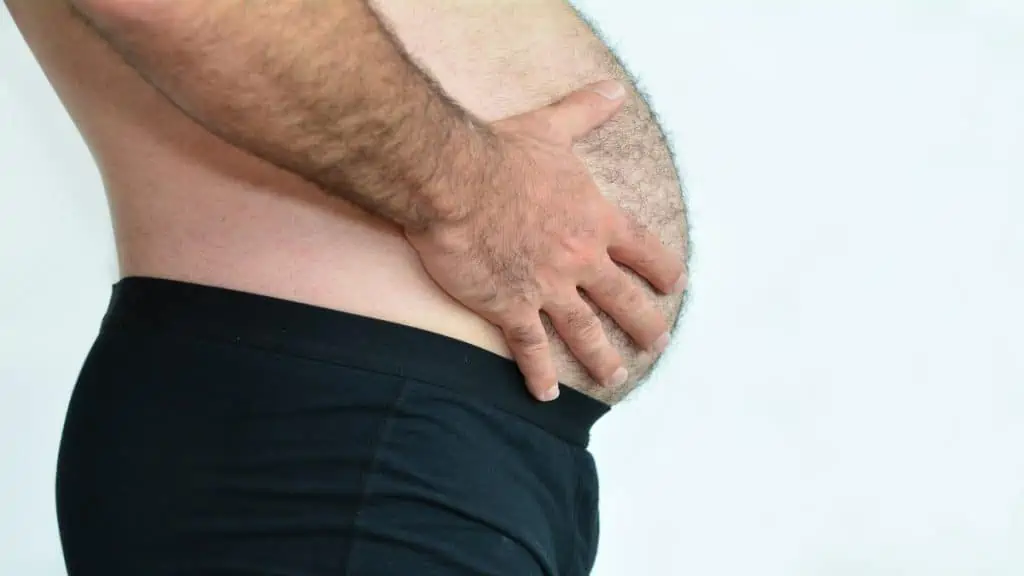We’ve talked a lot about waistline sizes on our website. And what’s clear from our research is that a 62 inch waist is much too big for an adult of any height and build to live in good health.
So, if you want to improve your health by reducing your waist measurement, this guide will help you to do just that by helping you make sustainable and yet effective lifestyle changes that naturally result in inches of waist reduction.
You can also check out our similar articles down below for different perspectives on other common waist sizes.
What’s wrong with having a 62 inch waist?

While you should never feel like you have to look a certain way, there are undeniable physical health consequences that are likely to arise when you have a 62 inch waist.
For example, it’s well-documented that having an excessively big waistline can cause chronic diseases like diabetes and heart disease. [1] This is because having a 62 in waist can impair your glucose tolerance and cause dangerous visceral fat to accumulate around your internal organs.
But in the short term, having a 62″ waist could also reduce your quality of life by causing joint pain, which would make it harder to accomplish everyday tasks and very uncomfortable to lose the weight via exercise.
How big is a 62 in waist?

Compared to the waist of the average American, a 62 inch waist is around 22-24 inches larger, depending on your age and gender. This can make it hard to find clothes that fit, which may make some individuals feel anxious and self-conscious about the way they look. [2]
It’s often recommended within the research community to keep your waist to less than half of your height. Or, to say it another way, your waist-to-height ratio should be less than 0.5.
So, since you likely aren’t 120 inches tall, you definitely need to shift some stomach fat if you want to improve your long-term physical health.
This metric is particularly useful because, unlike BMI, it measures your adiposity rather than just your weight. This is also why a reduction in waist size is one of the best indicators that you’re progressing in the right direction.
What can you do to reduce the size of your 62 inch waist?

Start by evaluating your current lifestyle and food choices. If you eat a lot of junk food, one of your main objectives should be to cook some of your own meals so that you can control the calorie and macronutrient content, which is essential for changing your body composition.
It might seem daunting to cook from scratch, but your meals don’t need to be fancy, and you can always batch cook to save time. There are countless delicious low-calorie recipes in cookbooks and online, so you’ll definitely find dishes that are tasty and yet conducive to slimming your 62 inch belly. [3]
If you currently lead a mostly sedentary lifestyle, then you should aim to increase your activity level. In practice, boosting your energy expenditure, which directly assists with weight loss, can be as simple as going for a walk during your lunch break or cycling to work.
Going to the gym might seem like another good idea, and it certainly is. However, hitting the gym is by no means a must for slimming your 62 inch waist. You can drop stomach fat at home by performing simple exercises—ideally in a superset or circuit fashion to kick up the intensity.
Investing in a pair of dumbbells and/or resistance bands, which are pretty affordable these days, opens up an ocean of new workout possibilities and enables you to target muscles that would be difficult to work with bodyweight movements.
The verdict: Who should slim their 62 inch waistline?

If you want to improve your health and reduce your risk of getting chronic diseases, then you should embark on a journey to reduce the size of your 62 inch waist.
There’s no need for you to get model-level slim, but improving your cardiovascular fitness, strengthening your muscles, and reducing your stomach size is only going to benefit you.
Just be sure to focus on achieving sustainable progress. There are many stories in the media of people losing massive amounts of weight really quickly. But you don’t know if these people managed to keep the weight off.
As such, you should set smaller goals to keep you motivated. Perhaps start by aiming for a weight loss of 20 lbs. This should yield a reduction in waist size, which means that you’d no longer have a 62″ waist.
References
- Li, S., Xiao, J., Ji, L., Weng, J., Jia, W., Lu, J., Zhou, Z., Guo, X., Liu, J., Shan, Z., Zhu, D., Chen, L., Zhao, Z., Tian, H., Ji, Q., Ge, J., Li, Q., Lin, L., Yang, Z., . . . Yang, W. (2014). BMI and waist circumference are associated with impaired glucose metabolism and type 2 diabetes in normal weight Chinese adults. Journal of Diabetes and Its Complications, 28(4), 470–476. https://doi.org/10.1016/j.jdiacomp.2014.03.015
- Simon, G. E., von Korff, M., Saunders, K., Miglioretti, D. L., Crane, P. K., van Belle, G., & Kessler, R. C. (2006). Association Between Obesity and Psychiatric Disorders in the US Adult Population. Archives of General Psychiatry, 63(7), 824. https://doi.org/10.1001/archpsyc.63.7.824
- Team, G. F. (2021, November 16). Low-calorie dinner recipes | BBC Good Food. BBC. https://www.bbcgoodfood.com/recipes/collection/low-calorie-dinner-recipes

